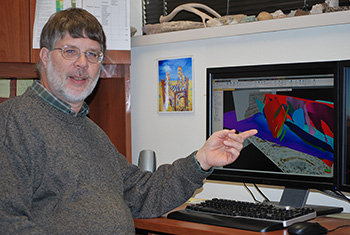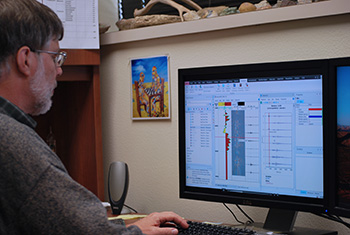Earth and space sciences gifted industry software from Schlumberger
 The Lamar University Department of Earth and Space Sciences has received two three-year software licenses valued at roughly $1.7 million for research use, from Schlumberger, the world’s leading supplier of technology, integrated project management and information solutions to customers working in the oil and gas industry.
The Lamar University Department of Earth and Space Sciences has received two three-year software licenses valued at roughly $1.7 million for research use, from Schlumberger, the world’s leading supplier of technology, integrated project management and information solutions to customers working in the oil and gas industry.
The software licenses will give students and faculty in the Department of Earth and Space Sciences access to two software packages: Petrel E&P software platform and Techlog wellbore software platform.
Petrel is an integrated software package that allows geologists, geophysicists, and reservoir engineers to work together seamlessly on oil and gas prospects and reservoir characterization studies. Resulting interpretations can be passed between the various workstations of geophysicists, geologists, engineers and managers to tweak interpretations as a group effort.
“Petrel is designed particularly for showing reflection seismic data, which is something that the petrol industry uses a lot. It’s one of the main ways to image the subsurface of an area. It’s much like an ultrasound that most people are familiar with, and it even uses sound waves like one,” said associate professor of geology and geophysicist Joseph Kruger, who is the faculty member assigned to the project.
Techlog is a software package that aids in interpreting borehole information. This information, obtained from a deep, narrow, exploratory hole, may include various geophysical well logs, core data, fluid data and cuttings data. Geological and petrophysical interpretations can then be made with the data and illustrated in Techlog.
“Techlog is able to take all of that information, analyze it, determine if it’s a good reservoir or not, and determine what the different types of rocks and formations are surrounding the borehole,” Kruger said. “Then, that data from Techlog can be sent right back into Petrel. The two softwares add fluidity to the processes of borehole assessment.”
Kruger and his students, many of whom aspire to enter the oil and natural gas industry, plan to use the software for research.
 “We will use both software packages for research projects that involve seismic data and borehole information. Some of these projects are related to the oil and gas industry and some of them are more academic in scope,” Kruger said. “I also want to make the software available for students taking our undergraduate seminar course in case they want to work on a project related to reflection seismology or geological interpretations using borehole data.”
“We will use both software packages for research projects that involve seismic data and borehole information. Some of these projects are related to the oil and gas industry and some of them are more academic in scope,” Kruger said. “I also want to make the software available for students taking our undergraduate seminar course in case they want to work on a project related to reflection seismology or geological interpretations using borehole data.”
Kruger also hopes the software will help students going into a variety of fields, specifically those relating to oil and gas.
“The biggest beneficiaries of this software are the students. To come in and actually get involved in a research project or seminar gives them a huge advantage,” he said. “They will benefit by getting hands-on training with industry standard software. If they’ve got some well control that they want to bring in, or if they want to do some subsurface mapping, they can use the software to gain experience in that and put it on their resume. It gives them a definite edge when they’re looking for jobs.”
Kruger is optimistic that this software will give Lamar an edge as well.
“The department will benefit by having this software available for faculty to use for their own research. Lamar University will benefit overall by demonstrating they have the tools to conduct research related to the oil and gas industry, and by having students graduate with the training they need to compete for jobs in the oil industry,” he said. “Having students get jobs in the fields they were trained for is always a benefit to the university.”


